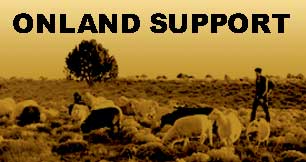Letter to U.N. Special Rapporteur Mr. Amor from Thayer Scudder
January 31, 1998 by pathfinder
Filed under Uncategorized
To: Abdelfattah Amor
Special Rapporteur of the United Nations Commission on Human Rights
From: Thayer Scudder
Professor of Anthropology
California Institute of Technology
I had hoped to be able to present this testimony to you in person, but in route back
from Hong Kong last week, I caught the flu which has kept me from traveling to Black
Mesa this weekend. I deeply regret that because I believe that the forced relocation
of Navajo and Hopi people that followed from the passage in 1974 of Public Law 93-531
is a major violation of the people’s human rights, including more specifically a
violation of their religious rights. Indeed, this forced relocation of over 12,000
Native Americans is one of the worst cases of involuntary community resettlement that
I have studied throughout the world over the past 40 years. While you are at Black
Mesa you will be given up-to-date information on the current situation. My testimony
is intended to provide background that I hope you will find useful.
Mr. Amor, please excuse me for describing my background in the paragraphs that follow.
They are intended to inform you that my conclusion about the serious human and
religious rights violations in the Navajo-Hopi case is based on a unique world-wide
familiarity with involuntary community resettlement. As a social scientist, my
research specialty since 1956 has been involuntary community relocation, with special
emphasis on resettlement in connection with large-scale dam construction. As a result
of that research, I have frequently worked as a resettlement consultant in Africa, Asia
and the Middle East for a number of UN agencies including UNDP, FAO, and WHO as well
as for the World Bank family. Currently I am a World Bank Consultant for one of the
first Bank projects to attempt the rehabilitation of communities previously relocated
in connection with the dam construction (in this case Zambia), as well as a member of
the Panel of International Environment and Resettlement Experts on World Bank-financed
projects in China, Lao Peoples’ Democratic Republic and Lesotho.
Acknowledged as the Dean of community resettlement studies, over the years I have
developed a theory on how a majority of rural people with strong ties to the land can
be expected to respond to forced relocation. The research on which that theory is
based led to World Bank’s original 1980 Operational Manual Statement 2.33 on “Social
Issues Associated with Involuntary Resettlement in Bank-Financed Projects.” Briefly
the theory explains why such resettlement, for a majority of those involved, can be
expected initially to lead to higher mortality and morbidity rates and psychological
stress among individuals as well as to cultural disorganization. In 1974 I was asked
by the Navajo Nation to inform the United States Congress through testimony before
the Senate Committee on Interior and Insular Affairs of my opinion that the
still-to-be-passed Public Law 93-531 could be expected to have equally serious impacts
on a majority of those involved.
Toward the end of my 1974 testimony I noted “that the compulsory relocation of entire
communities is an incredibly complex process which no governments have handled
satisfactory and that such governments tend to underestimate not just the complexities
involved but also the number of people involved, and the capital costs by a factor of
two or three… When we take into consideration the extreme human costs involved, it is
clear why forced relocation should be required by informed policy makers only as a last
resort. In the Navajo case, it is not too late to pursue a more humane alternative.”
I quote from the 1974 testimony in some detail to show that prior to passage of Public
Law 93-531 the US Congress choose to ignore warnings from such informed scientists
as myself. Actually even I underestimated the serious impacts that subsequent
resettlement would have. Not only have the number of people removed increased from
an original estimate of under 4,000 to over 12,000 with the financial cost estimates
rising from approximately $50 million to well over $300 million, but the psychological
stress has been unbearable for countless people (especially women). In addition the
predictable resettler-host population tensions have adversely affected Navajo-Navajo,
Navajo-Hopi, and Navajo-State of Arizona and State of New Mexico relationships.
This tragedy arises through a history of errors compounded by the insensitivity of the
United States Judicial System and the United States Congress to the issues involved.
Since you will be familiarized with them, let me highlight just a few. Two are the 1962
and 1966 court decisions to freeze all development in the Joint Use Area and the Bennett
Freeze Area, respectively, until the land dispute between the Hopi and Navajo was solved.
Those were incredibly insensitive decisions which not only stopped provision of basic
social services, but also construction of new housing and expansion and improvement of
old housing in areas that are among the most poverty stricken not just in the United
States but within the Navajo Reservation itself. So, for example, as children married
they were forced to move out of those areas or move into already overcrowded housing.
Another aspect of this tragedy was the extent to which outsiders made the land dispute
into a strictly Navajo-Hopi dispute when it’s origin was due far more to confused
Federal Government involvement over an extended time period. The situation was made
worse by the senior Democrat in the area (Udall) and Republican (Goldwater) advocating
the Hopi Tribal Government position for personal reasons that had very little to do
with the basic issues involved. But because of their similar views, the U.S. Congress
gave those issues far less attention than they deserved.
Mr. Amor, please bear in mind that this forced relocation of over 12,000 people whose
ties to their customary use areas (that is, their land) have very strong religious,
political, economic and psychological ties may well be the largest forced removal of
rural Americans since that of Japanese Americans during the Second World War. Not
only has it adversely affected the human rights and living standards of the majority
of people involved, but it has been largely implemented in a fashion that does not
even meet the minimum guidelines that the World Bank and the OECD countries require
for projects that they assist in other countries! First, World Bank and OECD
Guidelines require that compulsory resettlement be minimized to the extent possible.
Second, those guidelines require that resettlement projects must be development
projects. Yet aside from the minority of Navajo resettlers moved to the New Lands
over $300 million has been spent to date to make a majority of Navajo resettlers
worse off along with an unknown number of Navajo hosts who must now share a smaller
land base with a larger population. Mr. Amor, such a situation would never have
arisen in the United States if the people involved had been Anglo-Americans. That
alone, illustrates the extent to which the human rights of one of the poorest
minority groups in the United States have been violated.
Frankly, the situation as it has developed over the years appalls me for it is one
of the worse resettlement efforts that I have observed during a research career of
over 40 years. Certainly no further forced removal should be required which I
sincerely hope will be the position that results from your investigation.
Yours sincerely,
Thayer Scudder
Professor of Anthropology


